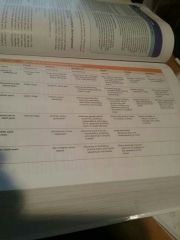![]()
![]()
![]()
Use LEFT and RIGHT arrow keys to navigate between flashcards;
Use UP and DOWN arrow keys to flip the card;
H to show hint;
A reads text to speech;
31 Cards in this Set
- Front
- Back
|
Developmental theories |

Freud, erikson, havighurst, piaget, fowler, kohlberg |
|
|
Freud stGez |
Oral stGe- 0-18 months-se urity is primary need Analysis stGe- 8 months-4 years. Toilet training set by social expectations Phallic stGe- 3-7 years possessiveness over opposite sex parent Latency stage- 7-12 years- sex role identification with same sex parents preparing for adult roles. Genital stGe-ovett sexual relationships |
|
|
Piaget theory-cognitive development |
Sensory motor stage- 0-18 month- basic reflexes 1-4 months-random behaviors such as smiling 4-8 monyhs- coordinates more than one thought pattern at a time to reach a goal only objects the are seen are permanent 12-18 months- recognizes permanence of objects, understand simple commands 18-24 months begins to anticipate events and reasoning Preoperational stage- 2-7 years use of symbols through language play activities help to understand life events Concrete operational- learn by manipulating concrete tangible objects, logical thinking develops, concepts of reversibility and loss of egocentricity. Formal operational stage- abstract thinking deductive reasoning |
|
|
Erikson |
Trust vs mistrust- infatuation relies on care giver to meet basic needs Autonomy vs shame- toddler learns environment and gains independence through encouragement Initiative vs guilt- preschooler takes initiative in learning shield actively seeks new experiences Industry vs inferiority- school age child gains pleasure from finishing projects and receiving recognition for accomplishments Identity vs role confusion- adolescents Intimacy vs isolation- young adult unite self identity and identity of friends Generativity vs stagnation- middle adult making contributions to the world or stagnating concentrating on own needs Ego integrity vs despair- later adulthood looking back at ones life |
|
|
Havighurst developmental task |
Infancy and early childhood- physiologic stability, eat solid food, distinguishing between right and wrong Middle childhood-physical skills, learning reading writing math, learning modesty and sex differences Adolescence-aquiring an ethical system, accepting of essential body, establishing gender roles Young adult-selecting a mate, starting a family, start an occupation Middle adult-accepting and adjusting to physical changes, adjust aging parents Later maturity-adjust decrease strength, deceased spouse, reduced income |
|
|
Development birth to 28 days |
Moro reflex, stepping reflex grasp reflex, hand to mouth activity, sucking, swallowing blinking, sneezing and yawning. Body temp responds quickly to external stimuli Senses respond to external stimuli Stool and urine are eliminated Has transient Immunity from I factions because of antibodies that cross placenta. Breastfeeding feeding also provides protection against diseases |
|
|
Infant- 1 month to 1year |
Brain grows to about the half size of an adult Eyes begin to focus Birth weight triples in a year Motor abilities develop Safety issues important in this stage |
|
|
Toddler- 1 to 3 years |
Rapid growth especially in long Bo especially Use fingers to pick up small objects Drinks from a cup Eats with spoon Bladder control during the day Motor vehicle accidents, choking, burns, falling major cause of deaths |
|
|
Health promotion |
Science art of helping get people change their lifestyle to move toward a state of optimal health |
|
|
Health protection |
Measures to protect large population groups. Rather than the individual |
|
|
Leading cause of death for 25-34 |
Unintentional injuries, suicide, homocide |
|
|
Leading cause of death 35-44 |
Unintentional injuries, malignant neoplasms, heart disease, |
|
|
Leading cause of death 45-54 |
Malignant neoplasms, heart disease, unintentional injuries |
|
|
Leading cause of death 55-64 |
Heart disease, malignant neoplasms, chronic low respiratory disease |
|
|
Leading cause of death 65 and older |
Malignant neoplasm, cerebrovascular disease |
|
|
3 goals for adult health from healthy people 2010 |
Attaining higher quality, longer lives for for preventable disease, disabilities, injury and premature death Achieving health equity, eliminating disparities, improving the health of all Promoting quality of life, healthy development |
|
|
Cholesterol should be checked in women |
From age 45 |
|
|
Cholesterol should be checked in men |
From age 35 |
|
|
Colorectal cancer is the 2nd leading cause of death from cancer. Risk factors |
No regular exercise, low fruit and veggie intake, low fiber alcohol consumption |
|
|
Skin cancer is most common form of cancer, risk factors |
Light skin, family history, large moles, moles that become painful |
|
|
Who suffers greatest from depressin |
Adults and older adults, women affected twice as much as men |
|
|
Which age group does sad affects the most |
15-24 |
|
|
Which age group does his affect the most |
Over 25 |
|
|
What disease is the number one killer of women |
Heart disease |
|
|
What components are used in the Denver 2 developmental screening test |
Personal-social Fine motor skills-adaptive Language Gross motor skills |
|
|
At what age should a Denver 2 be administered |
Between 3 to 4 months of age again at 10 months, then 3 years |
|
|
3 types of therapeutic play |
Energy release-release energy by pounding, kicking Dramatic play-acting out anxiety producing situations Creative play-drawing pictures |
|
|
Symptoms of heart attack differs from young to old. |
Older people may suffer from altered mental status rather than the usual chest pain. Older people may also complain of upper body pain burning g, or discomfort. |
|
|
Medications for alzheimers |
Aricept, exelon, razadyne, increase acetylcholine uptake. Combine with namenda and cognitive therapy. |
|
|
Geriatric triad |
Cognitive status, falls, incontinence |
|
|
Urinary incontinence is caused by |
Dehydration, delirium, restricted mobility, infalmmation, infection, impaction, pharmaceutical, polyuria |

